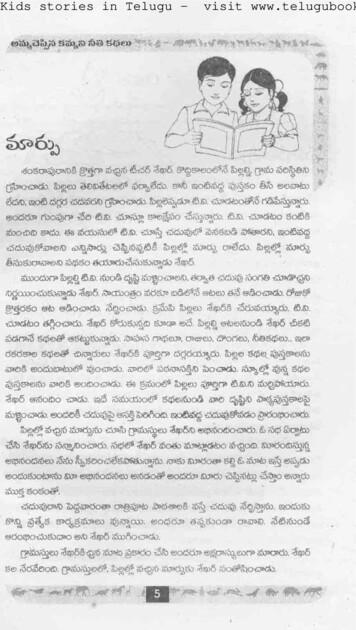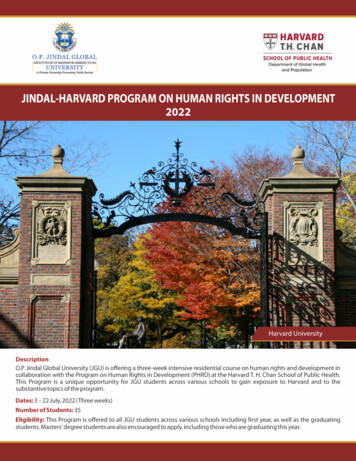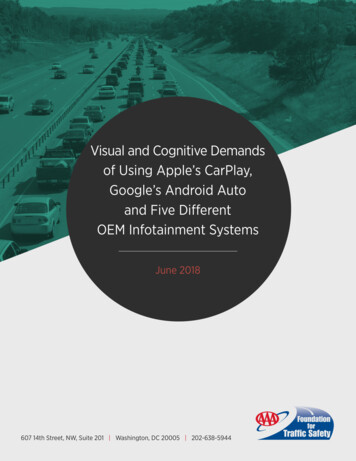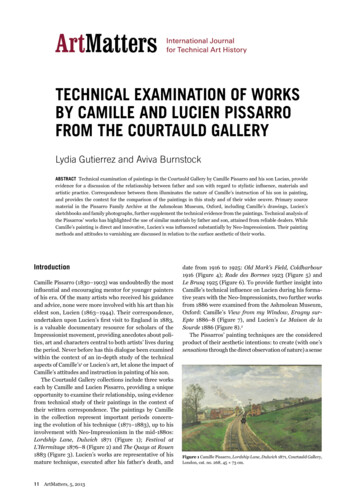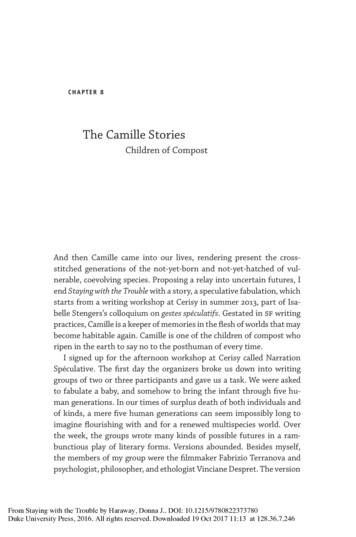
Transcription
CHAPTER 8The Camille StoriesChildren of CompostAnd then Camille came into our lives, rendering present the crossstitched generations of the not-yet-born and not-yet-hatched of vulnerable, coevolving species. Proposing a relay into uncertain futures, Iend Staying with the Trouble with a story, a speculative fabulation, whichstarts from a writing workshop at Cerisy in summer 2013, part of Isabelle Stengers’s colloquium on gestes spéculatifs. Gestated in sf writingpractices, Camille is a keeper of memories in the flesh of worlds that maybecome habitable again. Camille is one of the children of compost whoripen in the earth to say no to the posthuman of every time.I signed up for the afternoon workshop at Cerisy called NarrationSpéculative. The first day the organizers broke us down into writinggroups of two or three participants and gave us a task. We were askedto fabulate a baby, and somehow to bring the infant through five human generations. In our times of surplus death of both individuals andof kinds, a mere five human generations can seem impossibly long toimagine flourishing with and for a renewed multispecies world. Overthe week, the groups wrote many kinds of possible futures in a rambunctious play of literary forms. Versions abounded. Besides myself,the members of my group were the filmmaker Fabrizio Terranova andpsychologist, philosopher, and ethologist Vinciane Despret. The versionFrom Staying with the Trouble by Haraway, Donna J. DOI: 10.1215/9780822373780Duke University Press, 2016. All rights reserved. Downloaded 19 Oct 2017 11:13 at 128.36.7.246
8.1. Mariposa mask, Guerrero, Mexico, 62 cm 72.5 cm 12.5 cm, before1990, Samuel Frid Collection, UBC Museum of Anthropology, Vancouver.Installation view, The Marvellous Real: Art from Mexico, 1926–2011 exhibition(October 2013—March 2014), UBC Museum of Anthropology. Curator NicolaLevell. Photograph by Jim Clifford.From Staying with the Trouble by Haraway, Donna J. DOI: 10.1215/9780822373780Duke University Press, 2016. All rights reserved. Downloaded 19 Oct 2017 11:13 at 128.36.7.246
I tell here is itself a speculative gesture, both a memory and a lure for a“we” that came into being by fabulating a story together one summerin Normandy. I cannot tell exactly the same story that my cowriterswould propose or remember. My story here is an ongoing speculativefabulation, not a conference report for the archives. We started writing together, and we have since written Camille stories individually,sometimes passing them back to the original writers for elaboration,sometimes not; and we have encountered Camille and the Children ofCompost in other writing collaborations too.1 All the versions are necessary to Camille. My memoir for that workshop is an active casting ofthreads from and for ongoing, shared stories. Camille, Donna, Vinciane,and Fabrizio brought each other into copresence; we render each othercapable.The Children of Compost insist that we need to write stories and livelives for flourishing and for abundance, especially in the teeth of rampaging destruction and impoverization. Anna Tsing urges us to cobbletogether the “arts of living on a damaged planet”; and among those artsare cultivating the capacity to reimagine wealth, learn practical healingrather than wholeness, and stitch together improbable collaborationswithout worrying overmuch about conventional ontological kinds.2 TheCamille Stories are invitations to participate in a kind of genre fictioncommitted to strengthening ways to propose near futures, possible futures, and implausible but real nows. Every Camille Story that I writewill make terrible political and ecological mistakes; and every story asksreaders to practice generous suspicion by joining in the fray of inventinga bumptious crop of Children of Compost.3 Readers of science fiction areaccustomed to the lively and irreverent arts of fan fiction. Story arcs andworlds are fodder for mutant transformations or for loving but perverseextensions. The Children of Compost invite not so much fan fiction assym fiction, the genre of sympoiesis and symchthonia—the coming together of earthly ones. The Children of Compost want the Camille Stories to be a pilot project, a model, a work and play object, for composingcollective projects, not just in the imagination but also in actual storywriting. And on and under the ground.Vinciane, Fabrizio, and I felt a vital pressure to provide our baby witha name and a pathway into what was not yet but might be. We also felta vital pressure to ask our baby to be part of learning, over five generations, to radically reduce the pressure of human numbers on earth,currently set on a course to climb to more than 11 billion by the end of136chapter eightFrom Staying with the Trouble by Haraway, Donna J. DOI: 10.1215/9780822373780Duke University Press, 2016. All rights reserved. Downloaded 19 Oct 2017 11:13 at 128.36.7.246
the twenty-first century ce. We could hardly approach the five generations through a story of heteronormative reproduction (to use the uglybut apt American feminist idiom)! More than a year later, I realized thatCamille taught me how to say, “Make Kin Not Babies.”4Immediately, however, as soon as we proposed the name of Camille toeach other, we realized that we were now holding a squirming child whohad no truck with conventional genders or with human exceptionalism.This was a child born for sympoiesis—for becoming-with and makingwith a motley clutch of earth others.5Imagining the World of the CamillesLuckily, Camille came into being at a moment of an unexpected but powerful, interlaced, planetwide eruption of numerous communities of afew hundred people each, who felt moved to migrate to ruined placesand work with human and nonhuman partners to heal these places,building networks, pathways, nodes, and webs of and for a newly habitable world.6Only a portion of the earthwide, astonishing, and infectious actionfor well-being came from intentional, migratory communities like Camille’s. Drawing from long histories of creative resistance and generative living in even the worst circumstances, people everywhere foundthemselves profoundly tired of waiting for external, never materializingsolutions to local and systemic problems. Both large and small individuals, organizations, and communities joined with each other, and withmigrant communities like Camille’s, to reshape terran life for an epochthat could follow the deadly discontinuities of the Anthropocene, Capitalocene, and Plantationocene. In system-changing simultaneous wavesand pulses, diverse indigenous peoples and all sorts of other laboringwomen, men, and children—who had been long subjected to devastating conditions of extraction and production in their lands, waters,homes, and travels—innovated and strengthened coalitions to recraftconditions of living and dying to enable flourishing in the present andin times to come. These eruptions of healing energy and activism wereignited by love of earth and its human and nonhuman beings and byrage at the rate and scope of extinctions, exterminations, genocides,and immiserations in enforced patterns of multispecies living and dyingthat threatened ongoingness for everybody. Love and rage containedthe germs of partial healing even in the face of onrushing destruction.the camille stories137From Staying with the Trouble by Haraway, Donna J. DOI: 10.1215/9780822373780Duke University Press, 2016. All rights reserved. Downloaded 19 Oct 2017 11:13 at 128.36.7.246
None of the Communities of Compost could imagine that they inhabited or moved to “empty land.” Such still powerful, destructive fictions ofsettler colonialism and religious revivalism, secular or not, were fiercelyresisted. The Communities of Compost worked and played hard to understand how to inherit the layers upon layers of living and dying thatinfuse every place and every corridor. Unlike inhabitants in many otherutopian movements, stories, or literatures in the history of the earth, theChildren of Compost knew they could not deceive themselves that theycould start from scratch. Precisely the opposite insight moved them;they asked and responded to the question of how to live in the ruinsthat were still inhabited, with ghosts and with the living too. Comingfrom every economic class, color, caste, religion, secularism, and region,members of the emerging diverse settlements around the earth lived bya few simple but transformative practices, which in turn lured—becamevitally infectious for—many other peoples and communities, both migratory and stable. The communities diverged in their development withsympoietic creativity, but they remained tied together by sticky threads.The linking practices grew from the sense that healing and ongoingness in ruined places requires making kin in innovative ways. In theinfectious new settlements, every new child must have at least threeparents, who may or may not practice new or old genders. Corporeal differences, along with their fraught histories, are cherished. New childrenmust be rare and precious, and they must have the robust company ofother young and old ones of many kinds. Kin relations can be formedat any time in life, and so parents and other sorts of relatives can beadded or invented at significant points of transition. Such relationshipsenact strong lifelong commitments and obligations of diverse kinds. Kinmaking as a means of reducing human numbers and demands on theearth, while simultaneously increasing human and other critters’ flourishing, engaged intense energies and passions in the dispersed emergingworlds. But kin making and rebalancing human numbers had to happenin risky embodied connections to places, corridors, histories, and ongoing decolonial and postcolonial struggles, and not in the abstract andnot by external fiat. Many failed models of population control providedstrong cautionary tales.Thus the work of these communities was and is intentional kinmaking across deep damage and significant difference. By the earlytwenty-first century, historical social action and cultural and scientificknowledges—much of it activated by anticolonial, antiracist, proqueer138chapter eightFrom Staying with the Trouble by Haraway, Donna J. DOI: 10.1215/9780822373780Duke University Press, 2016. All rights reserved. Downloaded 19 Oct 2017 11:13 at 128.36.7.246
8.2. Make Kin Not Babies. Sticker, 2 3 in., made by Kern Toy, Beth Stephens,Annie Sprinkle, and Donna Haraway.feminist movement—had seriously unraveled the once-imagined natural bonds of sex and gender and race and nation, but undoing the widespread destructive commitment to the still-conceived natural necessityof the tie between kin making and a treelike biogenetic reproductivegenealogy became a key task for the Children of Compost.The decision to bring a new human infant into being is strongly structured to be a collective one for the emerging communities. Further, noone can be coerced to bear a child or punished for birthing one outsidecommunity auspices.7 The Children of Compost nurture the born onesevery way they can, even as they work and play to mutate the apparatuses of kin making and to reduce radically the burdens of human numbers across the earth. Although discouraged in the form of individualdecisions to make a new baby, reproductive freedom of the person isactively cherished.This freedom’s most treasured power is the right and obligation ofthe human person, of whatever gender, who is carrying a pregnancy tochoose an animal symbiont for the new child.8 All new human membersof the group who are born in the context of community decision makingcome into being as symbionts with critters of actively threatened spethe camille stories139From Staying with the Trouble by Haraway, Donna J. DOI: 10.1215/9780822373780Duke University Press, 2016. All rights reserved. Downloaded 19 Oct 2017 11:13 at 128.36.7.246
cies, and therefore with the whole patterned fabric of living and dyingof those particular beings and all their associates, for whom the possibility of a future is very fragile. Human babies born through individualreproductive choice do not become biological symbionts, but they dolive in many other kinds of sympoiesis with human and nonhuman critters. Over the generations, the Communities of Compost experiencedcomplex difficulties with hierarchical caste formations and sometimesviolent clashes between children born as symbionts and those born asmore conventional human individuals. Syms and non-syms, sometimesliterally, did not see eye to eye easily.The animal symbionts are generally members of migratory species,which critically shapes the lines of visiting, working, and playing for allthe partners of the symbiosis. The members of the symbioses of theChildren of Compost, human and nonhuman, travel or depend on associates that travel; corridors are essential to their being. The restorationand care of corridors, of connection, is a central task of the communities;it is how they imagine and practice repair of ruined lands and waters andtheir critters, human and not.9 The Children of Compost came to seetheir shared kind as humus, rather than as human or nonhuman. Thecore of each new child’s education is learning how to live in symbiosis soas to nurture the animal symbiont, and all the other beings the symbiontrequires, into ongoingness for at least five human generations. Nurturing the animal symbiont also means being nurtured in turn, as well asinventing practices of care of the ramifying symbiotic selves. The humanand animal symbionts keep the relays of mortal life going, both inheriting and inventing practices of recuperation, survival, and flourishing.Because the animal partners in the symbiosis are migratory, eachhuman child learns and lives in nodes and pathways, with other people and their symbionts, in the alliances and collaborations needed tomake ongoingness possible. Literally and figurally, training the mindto go visiting is a lifelong pedagogical practice in these communities.Together and separately, the sciences and arts are passionately practicedand enlarged as means to attune rapidly evolving ecological naturalcultural communities, including people, to live and die well throughout thedangerous centuries of irreversible climate change and continuing highrates of extinction and other troubles.A treasured power of individual freedom for the new child is to choosea gender—or not—when and if the patterns of living and dying evokethat desire. Bodily modifications are normal among Camille’s people;140chapter eightFrom Staying with the Trouble by Haraway, Donna J. DOI: 10.1215/9780822373780Duke University Press, 2016. All rights reserved. Downloaded 19 Oct 2017 11:13 at 128.36.7.246
and at birth a few genes and a few microorganisms from the animalsymbiont are added to the symchild’s bodily heritage, so that sensitivityand response to the world as experienced by the animal critter can bemore vivid and precise for the human member of the team. The animalpartners are not modified in these ways, although the ongoing relationships with lands, waters, people and peoples, critters, and apparatusesrender them newly capable in surprising ways too, including ongoingEcoEvoDevo biological changes.10 Throughout life, the human personmay adopt further bodily modifications for pleasure and aesthetics orfor work, as long as the modifications tend to both symbionts’ wellbeing in the humus of sympoiesis.Camille’s people moved to southern West Virginia in the AppalachianMountains on a site along the Kanawha River near Gauley Mountain,which had been devastated by mountaintop removal coal mining. Theriver and tributary creeks were toxic, the valleys filled with mine debris,the people used and abandoned by the coal companies. Camille’s peopleallied themselves with struggling multispecies communities in the rugged mountains and valleys, both the local people and the other critters.11Most of the Communities of Compost that became most closely linkedto Camille’s gathering lived in places ravaged by fossil fuel extractionor by mining of gold, uranium, or other metals. Places eviscerated bydeforestation or agriculture practiced as water and nutrient mining andmonocropping also figured large in Camille’s extended world.Monarch butterflies frequent Camille’s West Virginia communityin the summers, and they undertake a many-thousand-mile migrationsouth to overwinter in a few specific forests of pine and oyamel fir incentral Mexico, along the border of the states of Michoacán and México.12 In the twentieth century, the monarch was declared the state insectof West Virginia; and the Sanctuarío de la Biosfera Mariposa Monarca(Monarch Butterfly Biosphere Reserve), a unesco World Heritage Siteafter 2008, was established in the ecoregion along the Trans-MexicanVolcanic Belt of surviving woodlands.Throughout their complex migrations, the monarchs must eat, breed,and rest in cities, ejidos, indigenous lands, farms, forests, and grasslandsof a vast and damaged landscape, populated by people and peoples livingand dying in many sorts of contested ecologies and economies. The larvae of the leap-frogging spring eastern monarch migrations from southto north face the consequences of genetic and chemical technologies ofmass industrial agriculture that make their indispensable food—thethe camille stories141From Staying with the Trouble by Haraway, Donna J. DOI: 10.1215/9780822373780Duke University Press, 2016. All rights reserved. Downloaded 19 Oct 2017 11:13 at 128.36.7.246
leaves of native, local milkweeds—unavailable along most of the routes.Not just the presence of any milkweed, but the seasonal appearance of local milkweed varieties from Mexico to Canada, is syncopated in the fleshof monarch caterpillars. Some milkweed species flourish in disturbedland; they are good pioneer plants. The common milkweed of centraland eastern North America, Asclepias syriaca, is such an early successionalplant. Milkweeds thrive on roadsides and between crop furrows, andthese are the milkweeds that are especially susceptible to herbicides likeMonsanto’s glyphosphate-containing herbicide, Roundup. Another milkweed is also important to the eastern migration of monarchs, namely theclimax prairie species native to grasslands in later successional stages.With the nearly complete destruction of climax prairies across NorthAmerica, this milkweed, Asclepias meadii, is fiercely endangered.13Throughout the spring, summer, and fall, a large variety of early,midseason, and late flowering plants, including milkweed blossoms,produce the nectar sucked greedily by monarch adults. On the southernjourney to Mexico, the future of the North American eastern migrationis threatened by loss of the habitats of nectar-producing plants to feedthe nonbreeding adults flying to overwinter in their favorite roostingtrees in mountain woodlands. These woodlands in turn face naturalcultural degradation in complex histories of ongoing state, class, andethnic oppression of campesinos and indigenous peoples in the region,for example, the Mazahuas and Otomi.14Unhinged in space and time and stripped of food in both directions,larvae starve and hungry adults grow sluggish and fail to reach theirwinter homes. Migrations fail across the Americas. The trees in central Mexico mourn the loss of their winter shimmying clusters, and themeadows, farms, and town gardens of the United States and southernCanada are desolate in summer without the flitting shimmer of orangeand black.For the child’s symbionts, Camille 1’s birthing parent chose monarchbutterflies of North America, in two magnificent but severely damagedstreams, from Canada to Mexico, and from the state of Washington,along California, and across the Rocky Mountains. Camille’s gestationalparent exercised reproductive freedom with wild hope, choosing to bondthe soon-to-be-born fetus with both the western and eastern currentsof this braid of butterfly motion. That meant that Camille of the firstgeneration, and further Camilles for four more human generations atleast, would grow in knowledge and know-how committed to the on142chapter eightFrom Staying with the Trouble by Haraway, Donna J. DOI: 10.1215/9780822373780Duke University Press, 2016. All rights reserved. Downloaded 19 Oct 2017 11:13 at 128.36.7.246
goingness of these gorgeous and threatened insects and their humanand nonhuman communities all along the pathways and nodes of theirmigrations and residencies in these places and corridors, not all the timeeverywhere. Camille’s community understood that monarchs as a widespread global species are not threatened; but two grand currents of acontinental migration, a vast connected sweep of myriad critters livingand dying together, were on the brink of perishing.The child-bearing parent who chose the monarch butterfly as Camille’ssymbiont was a single person with the response-ability to exercise potent,noninnocent, generative freedom that was pregnant with consequencesfor ramifying worlds across five generations. That irreducible singularity, that particular exercise of reproductive choice, set in train a severalhundred-year effort, involving many actors, to keep alive practices of migration across and along continents for all the migrations’ critters. TheCommunities of Compost did not align their children to “endangeredspecies” as that term had been developed in conservation organizationsin the twentieth century. Rather, the Communities of Compost understood their task to be to cultivate and invent the arts of living with andfor damaged worlds in place, not as an abstraction or a type, but as andfor those living and dying in ruined places. All the Camilles grew richin worldly communities throughout life, as work and play with and forthe butterflies made for intense residencies and active migrations witha host of people and other critters. As one Camille approached death, anew Camille would be born to the community in time so that the elder,as mentor in symbiosis, could teach the younger to be ready.15The Camilles knew the work could fail at any time. The dangersremained intense. As a legacy of centuries of economic, cultural, andecological exploitation both of people and other beings, excess extinctions and exterminations continued to stalk the earth. Still, successfullyholding open space for other critters and their committed people alsoflourished, and multispecies partnerships of many kinds contributed tobuilding a habitable earth in sustained troubled times.The Camille StoriesThe story I tell below tracks the five Camilles along only a few threads and knotsof their lifeways, between the birth of Camille 1 in 2025 and the death of Camille 5in 2425. The story I tell here cries out for collaborative and divergent story-makingpractices, in narrative, audio, and visual performances and texts in materialitiesthe camille stories143From Staying with the Trouble by Haraway, Donna J. DOI: 10.1215/9780822373780Duke University Press, 2016. All rights reserved. Downloaded 19 Oct 2017 11:13 at 128.36.7.246
from digital to sculptural to everything practicable. My stories are suggestivestring figures at best; they long for a fuller weave that still keeps the patternsopen, with ramifying attachment sites for storytellers yet to come. I hope readerschange parts of the story and take them elsewhere, enlarge, object, flesh out, andreimagine the lifeways of the Camilles.The Camille Stories reach only to five generations, not yet able to fulfill theobligations that the Haudenosaunee Confederacy imposed on themselves and soon anyone who has been touched by the account, even in acts of unacknowledgedappropriation, namely, to act so as to be response-able to and for those in theseventh generation to come.16 The Children of Compost beyond the reach of theCamille Stories might become capable of that kind of worlding, which somehowonce seemed possible, before the Great Acceleration of the Capitalocene and theGreat Dithering.Over the five generations of the Camilles, the total number of human beingson earth, including persons in symbiosis with vulnerable animals chosen by theirbirth parent (syms) and those not in such symbioses (non-syms), declined fromthe high point of 10 billion in 2100 to a stable level of 3 billion by 2400. If theCommunities of Compost had not proved from their earliest years so successfuland so infectious among other human people and peoples, the earth’s populationwould have reached more than 11 billion by 2100. The breathing room provided bythat difference of a billion human people opened up possibilities for ongoingnessfor many threatened ways of living and dying for both human and nonhumanbeings.17CAMILLE 1Born 2025. Human numbers are 8 billion.Died 2100. Human numbers are 10 billion.In 2020, about three hundred people with diverse class, racial, religious,and regional heritages, including two hundred adults of the four majorgenders practiced at the time18 and one hundred children under the ageof eighteen, built a town where the New River and Gauley River flowedtogether to form the Kanawha River in West Virginia. They named thesettlement New Gauley to honor the lands and waters devastated bymountaintop removal coal mining. Historians of this time have suggested that the period between about 2000 and 2050 on earth shouldbe called the Great Dithering.19 The Great Dithering was a time of ineffective and widespread anxiety about environmental destruction, un144chapter eightFrom Staying with the Trouble by Haraway, Donna J. DOI: 10.1215/9780822373780Duke University Press, 2016. All rights reserved. Downloaded 19 Oct 2017 11:13 at 128.36.7.246
8.3. Monarch butterfly caterpillar Danaus plexippus on a milkweed pod.Photograph by Singer S. Ron, U.S. Fish and Wildlife Service.mistakable evidence of accelerating mass extinctions, violent climatechange, social disintegration, widening wars, ongoing human population increase due to the large numbers of already-born youngsters (eventhough birth rates most places had fallen below replacement rate), andvast migrations of human and nonhuman refugees without refuges.During this terrible period, when it was nonetheless still possible forconcerted action to make a difference, numerous communities emergedacross the earth. The English-language name for these gatherings wasthe Communities of Compost; the people called themselves compostists.Many other names in many languages also proposed the string figuregame of collective resurgence. These communities understood that theGreat Dithering could end in terminal crises; or radical collective actioncould ferment a turbulent but generative time of reversals, revolt, revolution, and resurgence.For the first few years, the adults of New Gauley did not birth anynew children, but concentrated on building culture, economy, rituals,and politics in which oddkin would be abundant, and children wouldbe rare but precious.20 The kin-making work and play of the community built capacities critical for resurgence and multispecies flourishing.In particular, friendship as a kin-making practice throughout life wasthe camille stories145From Staying with the Trouble by Haraway, Donna J. DOI: 10.1215/9780822373780Duke University Press, 2016. All rights reserved. Downloaded 19 Oct 2017 11:13 at 128.36.7.246
elaborated and celebrated. In 2025, the community felt ready to birththeir first new babies to be bonded with animal symbionts. The adultsjudged that most of their already-born children, who had helped foundthe community, were ready and eager to be older siblings to the comingsymbiont youngsters. Everybody believed that this kind of sympoiesishad not been practiced anywhere on earth before. People knew it wouldnot be simple to learn to live collectively in intimate and worldly caretaking symbiosis with another animal as a practice of repairing damagedplaces and making flourishing multispecies futures.Camille 1 was born among a small group of five children, and per21 wasthe only youngster linked to an insect. Other children in this first cohort became symbionts with fish (American eel, Anguilla rostrata), birds(American kestrel, Falco sparverius), crustaceans (the Big Sandy crayfish,Cambarus veteranus), and amphibians (streamside salamander, Ambystoma barbouri).22 Beginning with vulnerable bats, mammal symbioseswere undertaken in the second wave of births about five years later. Itwas often easier to identify migratory threatened insects, fish, mammals,and birds as potential symbionts for new children than reptiles, amphibians, and crustaceans. The preference for migratory symbionts was oftenrelaxed, especially since corridor conservation of all kinds was ever moreurgent as rising temperatures due to climate change forced many usually nonmigratory species outside their previous ranges. Although theirfirst loves remained traveling critters and far-flung pathways—mostlybecause their own small human communities were made geographicallyand culturally more worldly through cultivating the linkages required totake care of their partners in symbiosis—some members of the Communities of Compost committed themselves to critters in tiny remnanthabitats, as well as to those whose finicky ecological requirements andlove of home tied them tightly to particular places only.23Over the first hundred years, New Gauley welcomed 100 new birthswith babies joined to animal symbionts, 10 births to single parents orcouples who declined the three-parent model and whose offspring didnot receive these sorts of symbionts, 200 deaths, 175 in-migrants, and50 out-migrants. The scientists of the Communities of Compost found itimpossible to establish successful animal-human symbioses with adults;the critical receptive times for humans were fetal development, nursing,and adolescence. During the times that they contributed cellular or molecular materials for modifying the human partner, the animal partnersalso had to be in a period of
had no truck with conventional genders or with human exceptionalism. This was a child born for sympoiesis—for becoming-with and making-with a motley clutch of earth others.5 Imagining the World of the Camilles Luckily, Camille came into being at a moment of an unexpected but pow-erful, interlaced, planetwide eruption of numerous communities of a





